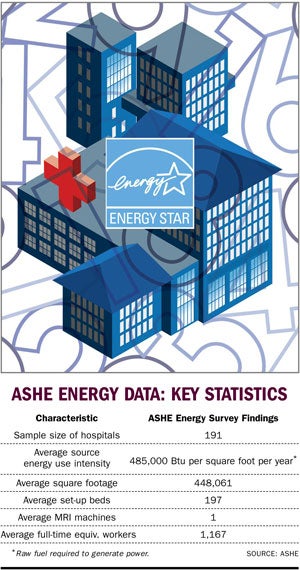Energy Star for Healthcare scores to get update
 A new energy performance scale for hospitals found in Energy Star's measurement and tracking tool, Portfolio Manager, is scheduled to replace the current scale on Nov. 7.
A new energy performance scale for hospitals found in Energy Star's measurement and tracking tool, Portfolio Manager, is scheduled to replace the current scale on Nov. 7.
The updated performance scale, which allows hospitals to see how they stack up against their peers across the country, is due to the success of a survey last year. The survey was conducted by the American Society for Healthcare Engineering (ASHE) in collaboration with the Environmental Protection Agency's (EPA) Energy Star for Healthcare program.
Data collected through the energy-use survey was used to update the current energy performance scale for hospitals, says Clark Reed, director, Healthcare Facilities Division, Energy Star, EPA, Washington, D.C.
The update as well as the retention of the rating system hinged on the success of the ASHE survey, because the prior rating system was likely becoming outdated, according to Reed.
"Energy performance scores are a cornerstone of this program because they allow you to ask the question, 'How does my hospital compare to my peers across the country?'" says Reed. "Knowing that allows you to set your targets, to know how long the journey is in terms of improving energy performance, and it allows EPA to recognize top-performing hospitals across the country."
EPA launched its energy performance scale for hospitals in 2001 based on survey data collected from the Electric Power Research Institute in 1997. Major changes in hospitals since 1997 created a need to update the rating, Reed says.
Key among changes since then are the growth of hospitals through expansion and new construction, increased use of electronic health records and increased use in energy-intensive medical equipment, he says.
The ASHE survey had more questions and elicited greater detail about the size and energy use of the responding hospitals than did the previous survey, says Reed. The increased level of detail enabled EPA to expand the rating system to new health care spaces, discover new energy drivers not probed in the 1997 survey and account for changes in energy-use intensities, he says.
The typical hospital in the survey, which had 191 respondents, had the following characteristics:
- Energy-use intensity average: 485,000 Btu per square foot per year.
- Size: 448,061 square feet.
- Number of beds: 197.
- Number of magnetic resonance imaging machines on site: 1.
- Number of full-time equivalent workers: 1,167.
Reed encourages hospitals that are eligible for Energy Star certification to apply now before their score changes and to schedule a licensed professional to validate the application to EPA.
By no later than Nov. 3, hospitals should print their Statement of Energy Performance and hard copy application, and then apply electronically for Energy Star.
They should send in the hard copy application to EPA within 90 days of the ending period of performance. The current Energy Star Portfolio Manager is scheduled to go offline on Nov. 4.
Facilities eligible to receive an Energy Star score include general medical and surgical hospitals, critical access hospitals and children's hospitals.
Information on an ASHE conference session about the new Energy Star rating system is available at www.ashe.org/e2c/ed/rating.html. For more information on Energy Star, visit www.energystar.gov/healthcare.




